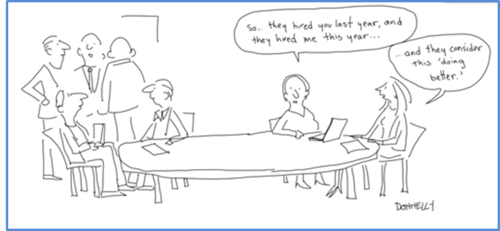There is no greater agony than bearing an untold story inside you. ― Maya Angelou
Liza Donnelly is a cartoonist and writer with The New Yorker Magazine, where she has been drawing cartoons about culture and politics for over thirty years. Donnelly's work has appeared in many national publications and she truly is one of the top cartoonists in the world. Liza Donnelly is also the author of fifteen books and an experienced public speaker, speaking at the United Nations and the first TED Women conference.
Donnelly (Twiiter: @lizadonnelly) started drawing when she was little as a coping mechanism and to help make people happy. After graduating from college, Donnelly moved to New York City and worked at a museum, while submitting cartoons to the New Yorker, and within two years, Donnelly sold her first cartoon.
I asked Donnelly to give us advice about the art of effective storytelling. Here are 10 ways to improve the art of storytelling:
1. A good story has a beginning, a compelling middle and an end
Donnelly says:
I usually do single panel cartoons - a single image. In a good cartoon, the beginning and end are implied. What you're seeing is the middle of the story. You can see the back story and you can see where these people came from, and where they're going.
A cartoon is like a little stage, and the cartoonist is a screenwriter, a set designer, a casting director and a choreographer - all of those things rolled into one.
2. A good storyteller is a great collaborator
As a cartoonist I work with my world around me, I work with the people around me. I rely on knowing what's going on around me and using it. I use what I see and what I sense and what I hear.
I'm always in touch with trends and buzzwords and what people are doing, and why they're doing it, and why I think they're doing it, and what's funny about what they're doing. Collaboration is working the world around you.
3. Good stories inspire and ignite reflection
Rarely do we cartoonists use phrases verbatim on people. People think we go to cocktail parties and you know eavesdrop. We don't do that. We're like sponges in a way, we pick up what's going on around us and soak up either knowingly or subconsciously and squeeze it back out.
Not all cartoons have meanings. By meaning, they don't have an ulterior motive except to make you laugh.
Donnelly's cartoons do have an ulterior motive. She draws cartoons hoping to get people to think about what they are doing, or to take note of something that they are doing that might be funny or wrong.
4. Share stories that are important and matter to you
I try to draw about everything that I can, mostly about American life or about Americans, people in this country. I'm focusing more on women's rights because I feel like the kind of cartoon I do can get at things going on in our culture that you might not be able to get from an article, or a traditional political cartoon.
The kind of cartoons I do are real slices of life, about interactions between people. So you can get at what's going on between two people in their bedroom, two people at a cocktail party, two people at a restaurant, or three people at a sports event and make them say things that exposes this silliness of certain cultural trends.
I feel the kind of cartoons I do are political, because politics seeps into our daily lives, and particularly for women, so that's one reason why I do a certain number of cartoons in my weekly batch about women's rights because I think it's important to write about that and to draw about that.
5. Great storytellers know their characters
It is better to be informed than opinionated.
Although I do it intuitively and I go to the same people, characters that I feel comfortable with that I know something about. Most of my cartoons are making fun of my demographic, because I know my demographic and you have got to draw or write about what you know otherwise it might ring false.
It is easier just to stick with what you know and it's probably more successful ultimately; because you don't want to falsely portray people in your stories.
6. Great storytellers are able to create stories with a twist
The first cartoon Donnelly sold to the New Yorker Magazine was a caption less cartoon with a twist.
Paul Cezanne, the artist has a theory of three elements in nature a cone, a sphere, a cylinder. That's what he bases his art theories on, and so I just come out of art school, you know art school, so I drew a cone, a sphere, and a cylinder that's the given, and I added to the picture a TV set.
So that's often what cartoon is, it's a twisting of reality, it's taking what we know and it makes it different and that's why you laugh, so that's good.
7. Humor is a powerful tool in storytelling
Referencing her TED talk, Donnelly spoke about the power of humor in storytelling.
Women plus humor equals change, what I meant by that was that humor is a powerful tool. If you go to anybody doing stand-up, they are in a powerful position. They're standing on that stage and they have control of their audience.
So it's a tool to make people laugh or to make people not laugh, and women don't use it enough. They don't use humor enough. I did my Ted talk five years ago and more and more women are getting into humor as we know, and using it as a tool to expose stupid things.
The thing about humor is that it sometimes can be an inclusive sort of force or divisive force. It's better to have inclusive type humor.
Donnelly concluded our interview by drawing a cartoon live. Drawing a live cartoon by one of the top cartoonist in the world was truly an extraordinary experience - perhaps one of my favorite moments of any show we've ever done since we started in 2013 (this was episode 119).
To learn more about the art of storytelling and the importance of stories in how they inspire and ignite purposeful action, please watch Liza Donnelly's interview here. Please join me and Michael Krigsman every Friday at 3PM EST as we host CXOTalk -- connecting with thought leaders and innovative executives who are pushing the boundaries within their companies and their fields.


